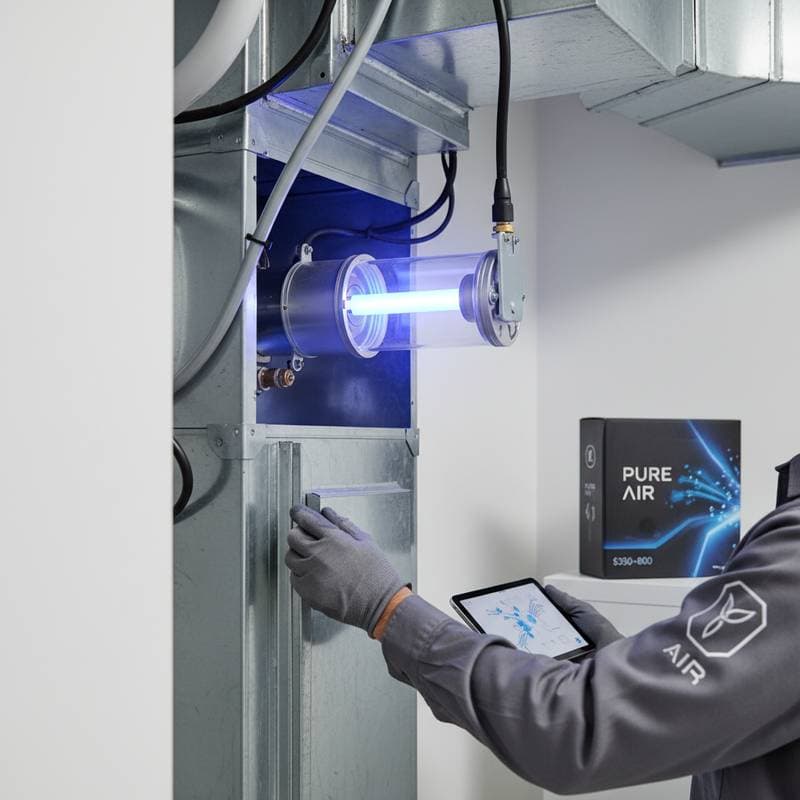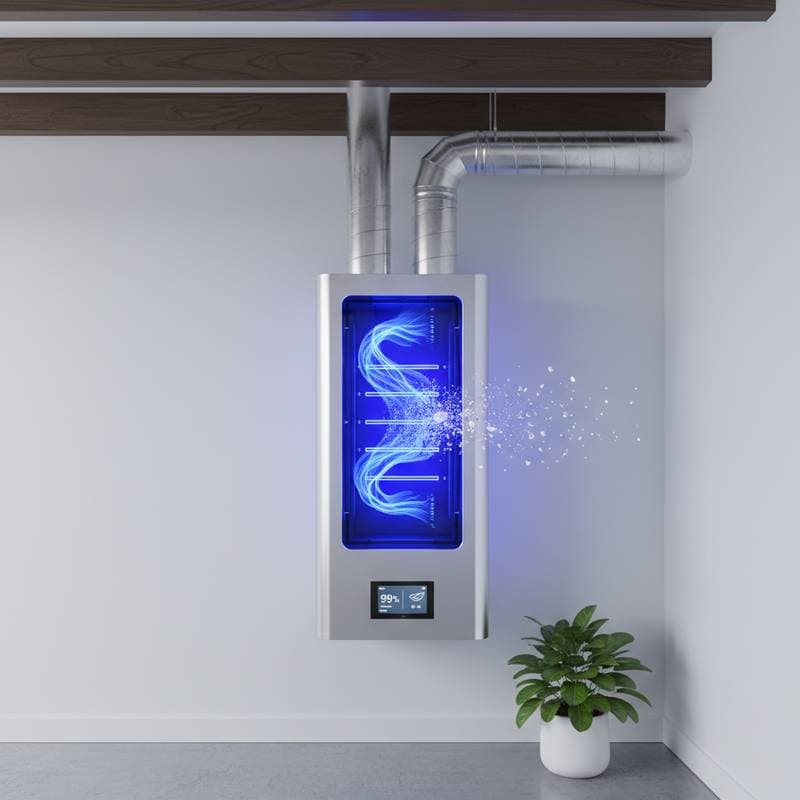The UV-C Boost HVAC Pros Demand for 2025 Air Quality
If you seek cleaner, healthier indoor air, UV-C light technology stands as one of the most effective upgrades for your HVAC system. Professional installers and indoor air quality experts increasingly rely on germicidal UV-C systems because these systems destroy airborne bacteria, viruses, mold spores, and allergens at their source. The outcome delivers fresher, safer air throughout your home. This guide details how UV-C light functions, associated costs, available types, and reasons it emerges as an essential feature for modern HVAC purification.
| Item | Average Cost |
|---|---|
| National Average Cost | $350 - $800 |
| Typical Price Range | $250 - $1,200 |
| Extreme High-End | $1,500+ |
| Extreme Low-End | $200 |
Average UV-C HVAC Light Costs
The expense of incorporating UV-C light into your HVAC system varies based on the unit type, its intensity, and placement in the air handler or ductwork. Most homeowners invest between $350 and $800 for a professionally installed UV-C system, which encompasses equipment and labor.
Cost by UV-C Light Type
- Coil Sterilization Lights: Positioned near the evaporator coil, these units continuously sanitize the coil surface and inhibit microbial growth. Costs range from $250 to $600.
- Air Sterilization Lights: Placed inside the ducts, these disinfect air as it travels through the system. Prices fall between $400 and $1,000, influenced by intensity and airflow coverage.
- Whole-House UV-C Systems: These integrate with advanced filtration and sensors for broad coverage. Expenses often surpass $1,200, providing comprehensive air purification.
Maintenance Costs
UV-C lights demand bulb replacement every one to two years, contingent on usage. A replacement bulb ranges from $75 to $150, with technicians handling the task during standard HVAC service.
Key Factors That Affect UV-C HVAC Light Price
Multiple variables determine the price of a UV-C system. Grasping these elements aids in selecting the appropriate configuration for your home and budget.
Unit Size and Intensity
Bulbs with higher wattage generate stronger germicidal action and manage greater air volumes. Compact homes may suffice with smaller systems, whereas larger residences or those with extensive ductwork require high-output bulbs or additional fixtures.
Installation Complexity
Limited space or restricted access to the coil or ducts in your HVAC system can extend installation time and elevate labor expenses. Older systems sometimes necessitate custom mounting hardware or electrical adjustments.
System Integration
Numerous UV-C systems connect with smart thermostats or air quality monitors. These sophisticated arrangements adjust UV intensity according to real-time readings, though they command higher prices than basic models.
Brand and Quality
Leading brands employ quartz glass bulbs and durable ballasts for reliable UV output. Budget alternatives may feature inferior glass or housings that wear out quickly. Selecting a trusted brand guarantees consistent performance and extended durability.
Professional vs. DIY Installation
Although some homeowners consider DIY options, professional installation secures precise placement, electrical safety, and optimal coverage. Improper setup diminishes effectiveness or introduces hazards, justifying the investment in expertise.
Types of UV-C HVAC Purification Systems
Selection of the ideal UV-C system hinges on your HVAC configuration, air quality objectives, and financial plan. Each variant offers distinct advantages and considerations.
Coil Sterilization Systems
These UV-C lights position near the evaporator coil to halt microbial accumulation.
Pros:
- Continuous disinfection of mold and bacteria on coil surfaces
- Enhanced airflow and efficiency through prevention of coil fouling
- Reduced maintenance for condensate pans and drain lines
Cons:
- Restricted to coil surface treatment, excluding airborne microbes
- Demands continuous operation for optimal results
Air Sterilization Systems
Installed within return or supply ducts, these lights target air directly.
Pros:
- Eliminates airborne contaminants prior to circulation
- Supports allergy and asthma management
- Diminishes odors from cooking or pets
Cons:
- Consumes more energy
- May need multiple units for expansive ducts
Hybrid UV-C Systems
These merge coil and air sterilization for complete protection.
Pros:
- Addresses both surfaces and circulating air
- Optimizes indoor air quality gains
- Suited for homes with health vulnerabilities
Cons:
- Elevates initial expenditure
- Necessitates accurate installation and calibration
Portable UV-C Air Purifiers
Though not HVAC-integrated, portable UV-C units augment central purification.
Pros:
- Offers placement flexibility
- Eliminates need for professional setup
Cons:
- Covers limited areas
- Involves regular filter and bulb upkeep
Signs You Need a UV-C HVAC Upgrade
Stale indoor air or HVAC performance issues signal the potential value of UV-C lights. Consider these indicators.
- Persistent odors despite cleaning efforts
- Indoor allergy or asthma flare-ups
- Visible mold adjacent to vents or coils
- Substantial dust accumulation in the home
- Diminished HVAC efficiency or inconsistent airflow
- Repeated respiratory concerns among residents
UV-C systems prove especially advantageous for homes with pets, infants, or individuals with weakened immunity. They foster a purer setting and curb pathogen transmission.
The UV-C Installation Process
Professional installation guarantees safety and efficacy. Expect these steps.
- Assessment and Planning: Technicians evaluate your HVAC to identify optimal bulb locations and power needs.
- System Preparation: HVAC power shuts off, and panels open for secure access.
- Mounting the UV Fixture: The housing secures near the coil or within ducts for targeted exposure.
- Electrical Connection: Wiring links to the air handler control or a dedicated circuit.
- Testing and Calibration: Activation verifies light strength and reach; sensors on select models confirm output.
- Safety Check: Shielding prevents human exposure, with inspections for light leaks.
- Maintenance Guidance: Instructions cover bulb replacement timing and inspection routines.
The procedure spans one to two hours, varying with system intricacy and access.
UV-C HVAC Labor Costs
Labor constitutes $150 to $300 of the total cost, fluctuating by location and design. Intricate ductwork or confined air handlers may extend time. Pairing UV-C work with services like coil cleaning or filter changes often lowers overall labor fees.
Specialized technicians align bulbs correctly and wire safely. Such expertise upholds warranties and adheres to disinfection standards.
Frequently Asked Questions About UV-C HVAC Systems
How does UV-C light clean the air?
UV-C light damages the DNA of microorganisms like bacteria, mold spores, and viruses, halting reproduction. Positioned in the HVAC, it neutralizes contaminants during air circulation, yielding purer air in all spaces.
Are UV-C HVAC systems safe for my family?
Yes, professional installation renders UV-C lights entirely safe. Enclosures within the HVAC or ducts block direct light from occupied areas. Adequate shielding and placement avert exposure risks.
Do UV-C lights replace air filters?
No, UV-C systems supplement filters. Filters trap dust and particulates, while UV-C eradicates organic threats filters miss. Combining both yields superior outcomes.
How long do UV-C bulbs last?
Bulbs endure 9,000 to 12,000 hours, equating to one or two years of nonstop operation. Output wanes over time, so prompt replacement sustains performance.
Can I install a UV-C light myself?
DIY suits certain coil systems, yet professionals are advisable. They manage wiring, positioning, and intensity for peak results. Errors can impair function or harm components.
Do UV-C lights increase energy costs?
Consumption remains low, akin to a minor bulb. Gains in coil efficiency and reduced HVAC load compensate for any minor draw.
Will UV-C light eliminate odors?
Yes, UV-C curbs odors from mold, bacteria, and duct buildup. Pairing with activated carbon filters best captures residual odor particles.
Schedule Your UV-C Consultation Today
Incorporating UV-C light into your HVAC elevates indoor air quality profoundly. It operates discreetly to neutralize germs, alleviate allergens, and inhibit mold within the system. Cleaner coils boost efficiency, while purer air minimizes health risks.
Contact a certified HVAC specialist for an assessment. They will tailor a UV-C solution to your setup, oversee installation, and secure lasting benefits. Obtain several estimates to identify the optimal investment for sustained well-being.





